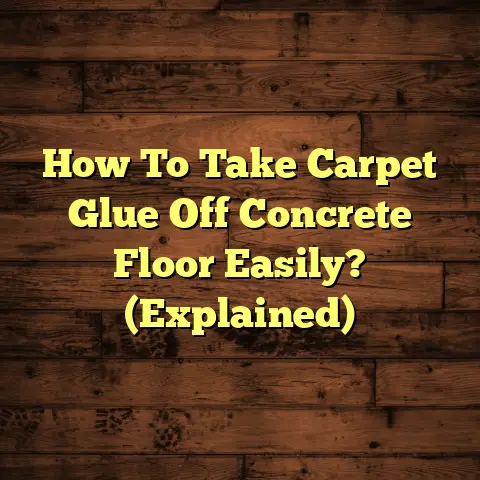Seal Tile/Wood Joints Perfectly! (7 Finish Secrets!)
Ever walked into a room and something just felt off, even if you couldn’t put your finger on it?
More often than not, it’s the little things that scream the loudest – like poorly sealed tile or wood joints.
Think of your flooring as a finely tuned orchestra.
Each tile, each plank, each joint plays a crucial role in the overall symphony.
If one instrument is out of tune, the whole piece suffers.
And those joints?
They’re the glue that holds everything together, literally and figuratively.
As a flooring contractor for over 15 years, I’ve seen firsthand the disastrous effects of neglecting these vital areas.
We’re talking water damage, mold, and floors that simply don’t last.
But don’t worry!
I’m here to let you in on my top 7 finish secrets for achieving perfectly sealed tile and wood joints.
Ready to transform your floors from “blah” to “bam”?
Let’s dive in!
Section 1: Understanding the Basics
of Tile and Wood Joints
So, what exactly are tile and wood joints?
Simply put, they’re the spaces between individual tiles or planks.
Without these joints, your flooring would buckle and crack.
Trust me, I’ve seen it happen!
Different materials call for different approaches.
Tile joints are typically filled with grout, a cement-based material that comes in a variety of colors.
Wood joints, on the other hand, are often sealed with caulk or flexible fillers that accommodate movement.
Think about the materials themselves.
Ceramic tile?
Porcelain?
Natural stone?
Each has different porosity and reacts differently to moisture.
Wood, too, varies wildly.
Hardwoods like oak and maple behave differently than softwoods like pine.
And don’t forget engineered wood, which has its own unique set of considerations.
Expansion and contraction is the name of the game.
Wood expands when it absorbs moisture and contracts when it dries out.
Tile also expands and contracts, although to a lesser degree.
According to the National Wood Flooring Association (NWFA), wood flooring can expand and contract as much as 1/4 inch over a 12-foot span, depending on the species and moisture content.
That’s why flexible sealants are so important!
Failing to account for this movement is a recipe for disaster.
Section 2: The Importance of Sealing Joints
Why bother sealing joints in the first place?
It’s all about protection, durability, and aesthetics.
Think of your grout or sealant as a shield, defending your subfloor from moisture, dirt, and grime.
Moisture is the enemy!
Unsealed joints are like open invitations to water damage.
Water can seep beneath the flooring, leading to mold growth, rot, and structural damage.
And let me tell you, mold remediation is not a fun or cheap process.
Plus, unsealed joints are magnets for dirt and debris.
Try cleaning grout that’s been exposed to years of grime – it’s nearly impossible!
Sealing makes cleaning a breeze and keeps your floors looking fresh for longer.
Durability is key, right?
Sealing protects the edges of your tiles and planks from chipping and cracking.
It also prevents the grout or filler from crumbling and deteriorating over time.
A well-sealed floor is a floor that lasts.
Let me give you a real-life example.
I once worked on a house where the homeowners had neglected to seal the grout in their bathroom for years.
The result?
Black mold growing in the grout lines, water damage to the subfloor, and a musty odor that permeated the entire house.
The cost to repair the damage was thousands of dollars.
A simple sealing job would have prevented the whole mess.
According to the Tile Council of North America (TCNA), properly sealed grout can extend the life of a tile installation by up to 50%.
That’s a significant return on investment!
Section 3: The 7 Finish Secrets for
Perfectly Sealed Joints
Alright, let’s get to the good stuff!
Here are my 7 finish secrets for achieving perfectly sealed tile and wood joints, based on years of experience and countless flooring projects.
Secret 1: Choose the Right Sealing Material
This is where it all begins.
Choosing the right sealant is crucial for success.
There’s no one-size-fits-all solution.
For tile grout, you’ll typically want to use a penetrating sealer specifically designed for grout.
These sealers soak into the grout, creating a waterproof barrier without changing its appearance.
For wood joints, you have more options.
Caulk is a popular choice, especially for areas that are prone to movement.
Look for a paintable caulk that matches your trim or flooring.
Silicone sealants are another option, but they can be difficult to paint.
Polyurethane sealants are known for their durability and flexibility, making them a good choice for high-traffic areas.
How do you decide?
Consider the type of flooring, the location of the joint, and the environmental conditions.
For example, a bathroom floor will require a more water-resistant sealant than a living room floor.
And if you live in an area with extreme temperature fluctuations, you’ll want to choose a sealant that can handle the expansion and contraction.
I always recommend reading the manufacturer’s instructions carefully before choosing a sealant.
They’ll provide valuable information about the product’s intended use and limitations.
Secret 2: Prepare the Surface Properly
Preparation is key to any successful flooring project, and sealing joints is no exception.
You can’t just slap sealant on a dirty surface and expect it to last.
The first step is to clean the joints thoroughly.
Remove any dirt, dust, debris, or old sealant.
A stiff brush and a vacuum cleaner can work wonders.
For stubborn stains, you may need to use a specialized cleaner designed for grout or wood.
Once the joints are clean, make sure they’re completely dry.
Moisture can prevent the sealant from bonding properly, leading to premature failure.
I like to use a hairdryer or heat gun to speed up the drying process, but be careful not to overheat the surface.
Finally, inspect the joints for any cracks or damage.
Repair any imperfections before applying the sealant.
A small amount of patching compound can fill in cracks and create a smooth, even surface.
According to a study by the National Association of Home Builders (NAHB), proper surface preparation can increase the lifespan of a sealant by up to 30%.
That’s a significant difference!
Secret 3: Apply the Sealant with Precision
Now for the fun part!
Applying the sealant requires a steady hand and a bit of practice.
If you’re using caulk or silicone, load the sealant into a caulking gun.
Cut the tip of the nozzle at a 45-degree angle, making the opening slightly smaller than the width of the joint.
Apply the sealant in a smooth, continuous bead, holding the gun at a consistent angle.
Don’t try to fill the entire joint in one pass.
It’s better to apply multiple thin layers than one thick layer.
If you’re using a grout sealer, follow the manufacturer’s instructions carefully.
Some sealers are applied with a brush, while others are sprayed on.
Be sure to wipe off any excess sealer from the tile surface immediately.
Overfilling or underfilling the joints is a common mistake.
Too much sealant can create a messy, uneven finish.
Too little sealant can leave gaps that allow moisture to penetrate.
The goal is to fill the joint completely without overflowing.
Secret 4: Use the Right Tools for the Job
Having the right tools can make all the difference in the world.
A good caulking gun is essential for applying caulk or silicone smoothly and evenly.
Look for a gun with a comfortable grip and a smooth trigger action.
Smoothing tools are used to create a professional-looking finish on the sealant.
These tools come in a variety of shapes and sizes, so choose one that fits the width of your joints.
A grout float is used to apply grout evenly and pack it tightly into the joints.
A sponge is used to clean up excess grout and smooth the surface.
A putty knife is useful for scraping away old sealant and cleaning up spills.
And don’t forget the basics: a bucket of clean water, a rag, and a pair of gloves.
Investing in quality tools will not only make the job easier, but it will also improve the quality of the finished seal.
Secret 5: Timing is Everything
Timing is crucial in the sealing process.
You need to allow the sealant to dry completely before exposing it to moisture or traffic.
The drying time will vary depending on the type of sealant and the environmental conditions.
Check the manufacturer’s instructions for specific recommendations.
Temperature and humidity can also affect sealing.
Avoid sealing joints in extreme temperatures or high humidity.
The ideal conditions are a moderate temperature and low humidity.
If you’re applying multiple coats of sealant, allow each coat to dry completely before applying the next one.
Rushing the drying process can lead to cracking, peeling, and other problems.
Secret 6: Finish with a Smooth Touch
A smooth finish is the hallmark of a professional sealing job.
After applying the sealant, use a smoothing tool to create a smooth, even surface.
Hold the tool at a slight angle and run it along the joint, removing any excess sealant.
Wipe the tool clean after each pass.
For grout, use a damp sponge to smooth the surface and remove any excess grout from the tile.
Be careful not to remove too much grout, as this can weaken the joint.
The goal is to create a seamless transition between the sealant and the surrounding surface.
A well-finished joint should be barely noticeable.
Secret 7: Regular Maintenance and Inspection
Sealing your joints is not a one-time task.
To maintain the integrity of the seal, you need to inspect the joints regularly and perform any necessary maintenance.
Look for cracks, gaps, or signs of deterioration.
If you notice any problems, address them immediately.
Small cracks can be repaired with a small amount of sealant.
Larger cracks may require removing the old sealant and applying a fresh coat.
Clean the joints regularly with a mild detergent and water.
Avoid using harsh chemicals or abrasive cleaners, as these can damage the sealant.
Reseal the joints every few years, or as needed.
The frequency of resealing will depend on the type of sealant and the amount of traffic the area receives.
According to the International Sanitary Supply Association (ISSA), regular maintenance can extend the life of a sealed surface by up to 25%.
Conclusion
Sealing tile and wood joints might seem like a small detail, but it can have a transformative effect on the overall appearance and longevity of your flooring.
By following these 7 finish secrets, you can achieve a seamless, professional look that will protect your floors from moisture, dirt, and damage.
Remember to choose the right sealant, prepare the surface properly, apply the sealant with precision, use the right tools, time the process carefully, finish with a smooth touch, and maintain the joints regularly.
With a little effort and attention to detail, you can create floors that are both beautiful and durable.
So go ahead, unleash your inner flooring pro and seal those joints like a boss!
Your floors (and your wallet) will thank you.





